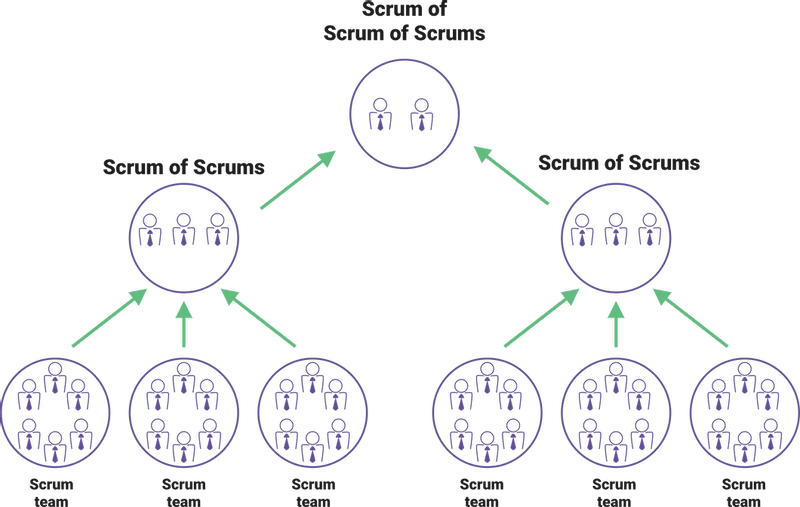Scrum of Scrums (SoS)
Most of us are familiar with the basic principle of Scrum: according to the so-called 7 +/- 2 rule, Scrum teams should be 5 to 9 members. At the same time, Scrum guide says Scrum teams should not be less than 3 or more than 9. There is a minimum of 3 members in a Scrum team due to the fact that there are 3 major roles that are essential:
- Product Owner
- Development Team
- Scrum Master
And in a perfect scenario, there are no more than 9 members in a Scrum team to ensure that management and communication are kept as simple and effective as possible. Larger teams have more communication channels between team members, making it harder to create trust, respect and a sense of common purpose. Teams that are too small or large might struggle with the delivery of complex products.
How do organizations deal with projects that have a lot of people working on it? Let's say there are 500 people on the same project and you want to use Scrum. Is it not applicable? Yes, it is applicable. Scrum can be used on large projects regardless of the number of its members. But, rather than scaling by having a large team, Scrum projects scale through having teams of teams. This technique, when two or more Scrum teams have to coordinate their work instead of one large Scrum team is called Scrum of Scrums (SoS). It proved to be a great technique to connect multiple teams who need to work together to deliver complex solutions.
The Scrum of Scrums methodology, also known as 'Meta Scrum', was first implemented in 1996 by Jeff Sutherland and Ken Schwaber. With this technique, Scrum teams operate as usual, but each of these teams chooses a representative who attends the Scrum of Scrums meetings in order to coordinate the work of multiple Scrum teams. Similarly, extremely large projects with many teams may result in conducting a Scrum of Scrum of Scrums, when a representative from each Scrum of Scrums is reporting to a group of other representatives. This structure is represented in the following scheme:
Scrum of Scrums teams apply almost the same practices and have very similar roles as Scrum teams only with minor differences. Here are the main characteristics of a SoS:
Even though SoS meetings are similar to the daily Scrum meetings, they do not necessarily happen every day. Typically, SoS meetings take place two to three times a week, which is sufficient for most organizations. Anyway, the frequency of SoS meetings must be determined by the team.
There is one additional question to be discussed during SoS meetings in comparison to a regular Scrum meeting.
The agenda for a Scrum meeting is:
- Completed work (what was done yesterday?)
- Next set of work (what will be done today?)
- Any current impediments (are there obstacles that slow the work down?)
The agenda for a SoS meeting:
- Completed work (what was done yesterday?)
- Next set of work (what will be done today?)
- Any current impediments (are there obstacles that slow the work down?)
- Upcoming impediments that may block the other teams (will you put something in another team's way?)
The representatives of SoS meetings may change over the course of a typical project. Who is going to attend a SoS meeting depends greatly on the questions most likely to be discussed at that time during the project. As a web developer, I personally attended SoS meetings a few times and according to my experience, my participation was required typically early in the project, when technical issues were most likely to arise.
Similarly, if the work of the team is focused on design at the moment, a designer will most likely represent his/her Scrum team at the SoS meeting.
The SoS team size depends on the number of teams on the project. Let's say there are 3 or 4 teams on the project. Is it possible to send two representatives from each Scrum team? Yes, actually it is. If each team sends two members to a SoS meeting, the SoS team will be 6-8 members accordingly, which is totally fine.
To conclude it all, Scrum of Scrums facilitates cross-team coordination and ensures that the organization and individual Scrum teams are on the same page. Keep that technique in mind as it can be very effective in larger organizations with multiple teams.

